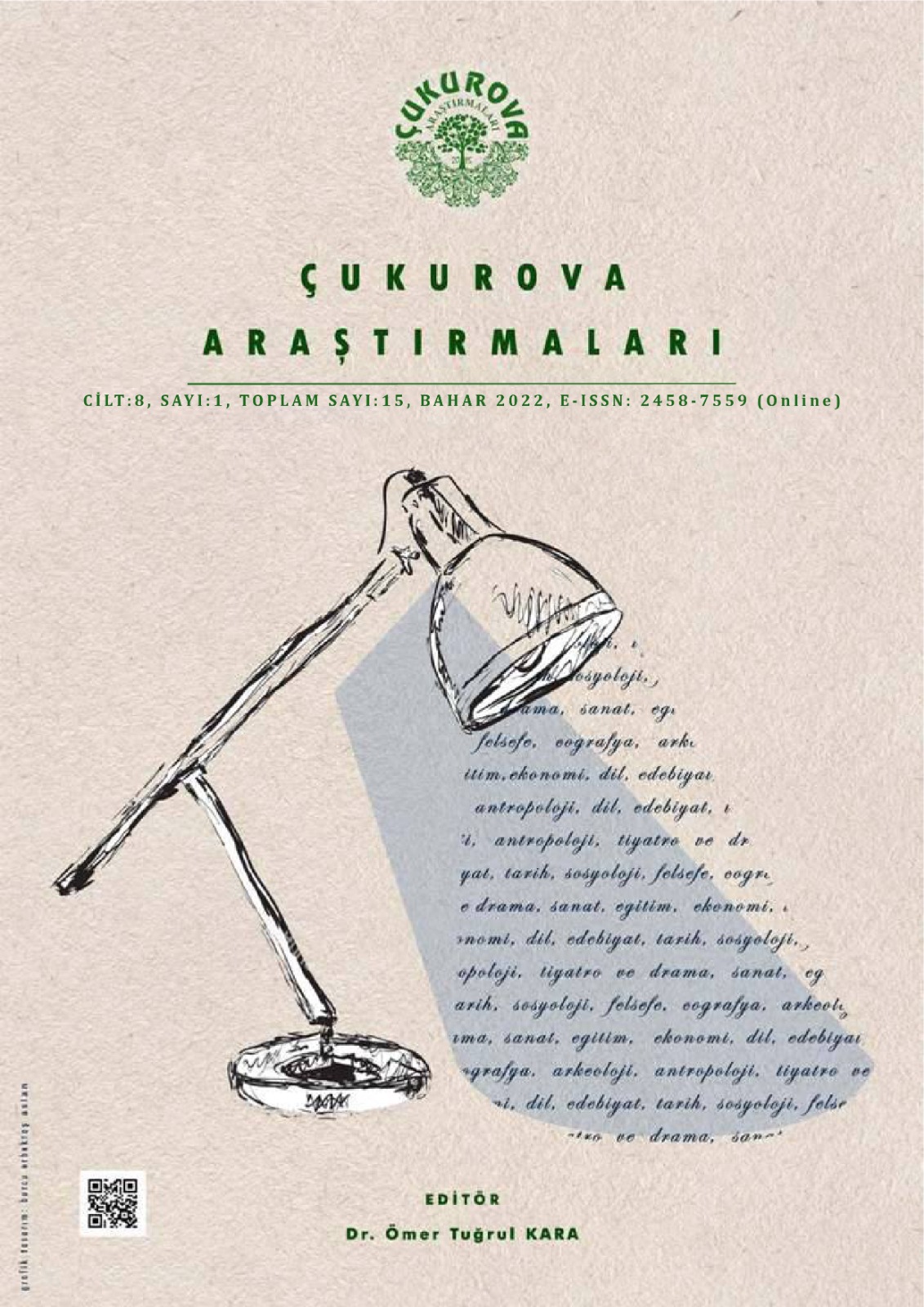Author :
Abstract
Kalemin kılıçtan, sözün silahtan etkili olduğunun farkına varan insanoğlu, yaşadıklarından öğrendiklerini daha etkili anlatabilmek için daima sanatın büyülü dilinden faydalanma yoluna gitmiştir. Toplumdaki sosyal, siyasal, tarihî vb. olayların üzerinde en çok etkili olduğu ve yansıdığı sanat dallarından biri edebiyattır. Toplumsal olaylarda en çok sıkıntı ve acı çeken ise halktır. Halkın yaşadıklarını ve çektiklerini en iyi yansıtan ise halkın içinden çıkmış, bir başka deyişle halkın içinde yaşayan sanatkârlar şairler ve âşıklardır. Yaşayanların ağzından özellikle bir sanat eseri ölçeğindeki mensur veya manzum anlatılar, taraflı tarafsız herkesin ilgisini çekmekte, gönlünde kalıcı izler bırakmaktadır.
Osmaniye çevresinde bundan yüz yıl önce işgal ve kurtuluş mücadelesinde yaşananlar ve bölgedeki halkın çektiği maddi ve manevi sıkıntılar en iyi yansımasını bu bölgenin âşıklarının ve şairlerinin dilinde ve kaleminde bulmuştur. Âşıklar ve şairler, bir yerde vicdanın sesi oldukları gibi, kendi millî değerlerinin de yansıtıcısı, savunucusu ve propagandacısıdırlar.
İnsanlar acılarını, sızılarını, umudunu çoğu zaman şiire döker, yeri geldiğinde şiirlerden tekrar devşirir. Bu tür şiirler, halkın hafızasını canlı tutar, geçmişi unutturmaz, böylece yaşadığı sıkıntılar karşısında direncini artırırlar. Bu bağlamda bu çalışmada Osmaniye'nin kurtuluşuyla ilgili olarak Osmaniyeli âşıklar ve şairler tarafından söylenilen şiirler incelenerek bu şiirlerin halk üzerindeki etkileri işlevsel açıdan değerlendirilmiştir.
Bu çalışmada literatür tarama ve metin analiz tekniği uygulanmıştır. Çalışmanın amacı, Osmaniye'nin kurtuluşuyla ilgili olarak yazılmış/söylenmiş şiirlerin halk üzerindeki etkilerini tespit etmektir.
Keywords
Abstract
Human beings have always sought to benefit from the magical language of art to more effectively express what they have learned from their experiences. Social, political, historical, etc. One of the branches of art in which events are reflected most and effectively is literature. It is the people who suffer the most in social events. The ones who best reflect the people's experiences and sufferings are the poets and minstrels who came out of the people, in other words, lived among the people. Narratives, especially on the scale of a work of art, from the mouths of the living, attract the attention of everyone and leave permanent traces in their hearts.
What happened around Osmaniye a hundred years ago during the occupation and liberation struggle and the material and moral troubles suffered by the people in the region found their best reflection in the language of the minstrels and poets of this region. Minstrels and poets are the voice of conscience and reflectors, defenders, and propagandists of their national values.
We pour our pain, ache, and hope into poetry, and when appropriate, we collect them again from poems. Such poems keep our memory alive do not make us forget the past, so they increase our resistance in the face of the troubles we experience. In this context, in this study, the poems sung by the minstrels and poets of Osmaniye about the liberation of Osmaniye were examined, and the effects of these poems on the people were evaluated functionally.
In this study, literature scanning and text analysis techniques were applied. The study aims to determine the effects of the poems written/sung about the liberation of Osmaniye on the people.
Keywords
- Alptekin, A. B. ve Coşkun, N. (2006). Çıldırlı Âşık Şenlik divanı. Ankara: Çıldır Belediyesi Yayınları.
- Artun, E. (2004). Osmaniye'de ağıt söyleme geleneği ve Osmaniye ağıtları. Karacaoğlan'dan Bela Bartok'a Dadaloğlu'ndan Âşık Feymani'ye Osmaniye Kültür Sanat ve Folklor Sempozyumu, 22-24 Kasım 2004. (ss.8-38). Osmaniye: Osmaniye Valiliği.
- Alver, K. (2006). Edebiyat ve kimlik. Bilgi Sosyal Bilimler Dergisi, (2), s.32-43. Retrieved from https://dergipark.org.tr/en/pub/bilgisosyal/issue/29118/311505 erişim tarihi: 22.11.2021.
- Bülbül, M., Türkoğlu, S. ve Küzeci, D. (2015). Edebiyat ve toplumsal işlevi", Atatürk Üniversitesi Kazım Karabekir Eğitim Fakültesi Dergisi, 0(29), s.1-11. Erişim tarihi: 22.11.2021, Retrieved from https://dergipark.org.tr/en/pub/ataunikkefd/issue/2787/37488
- Çobanoğlu, Ö. (2010). Halkbilimi kuramları ve araştırma yöntemleri tarihine giriş, Ankara: Akçağ Yayınları.
- Çobanoğlu, Ö. (1999). İşgal edilen vatan topraklarında âşık edebiyatının işlevleri, Millî Folklor, 42, 89-91.
- Dinçer, N. (1995). Osmaniye'nin kurtuluş savaşında Rahime hatun. K. Tülücü (ed.) Tarih içinde bütün yönleriyle Osmaniye 1. Sempozyum 15-18 Kasım 1993. (ss.43-61). Adana: Çukurova Üniversitesi Basımevi.
- Gizlice, A. (2012). Osmaniye ve yukarı Çukurova ağıtları. Osmaniye: Akdeniz Ofset.
- Gökşen, C. (2016). Kenan Alibekiroğlu hayatı-sanatı-şiirleri. Osmaniye: Akdeniz Ofset.
- Gökşen, C. ve Çetinkol, M. (2021). Mehmet Avşar hayatı, sanatı ve şiirleri. Osmaniye: Hasret Matbaası.
- Gökşen, C. (2012). Âşık Şenlik’in Kars’ın işgal yıllarında söylediği koçaklama ve destanların halk üzerindeki etkisi. Uluslararası Türkçe Edebiyat Kültür Eğitim Dergisi.: 1(3), 118-135.
- Görkem, İ. (2001). Türkiye'de ağıtlar / Çukurova ağıtları metin inceleme. Ankara: Akçağ Yayınları.
- Gürel, R. (1998). Osmaniye ve yedi ocak şiirleri antolojisi. Osmaniye: Osmaniye Belediyesi Yayınları.
- Karakaya, Z. (2014). Öğretici ve eğitici edebiyat üzerine bir deneme. Ondokuz Mayıs University Journal of Education Faculty. 11(1), 80-91. Erişim tarihi: 22.11.2021, Retrieved from https://dergipark.org.tr/en/pub/omuefd/issue/20259/21564.
- Kocaman, A. (2014). Yukarı Çukurova'da ağıtlar ve hikâyeleri. Adana: Ekrem Matbaası.
- Özdemir, N. (2009). Turizm ve edebiyat. Millî Folklor. 82, 32-49.
- Şimşek, E. (1993). Kadirli ve Osmaniye ağıtları, Antakya: Kültür Ofset.
- Şimşek, E. (2017). Ermeni mezalimini konu alan Çukurova ağıtları üzerine bir değerlendirme. 21. Yüzyılda Eğitim ve Toplum Eğitim Bilimleri ve Sosyal Araştırmalar Dergisi. 16 (6), 19-40.
- Gâvurdağı sesime ses vermeli (Gökşen-Çetinkol, 2021, s.147).
- Bugün düşman ağlarken Kadir Çavuş gülüyor (Gürel, 1998, s.62)





